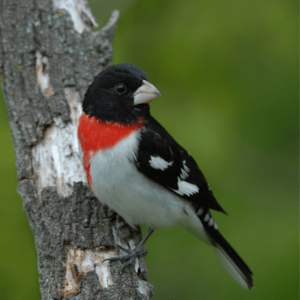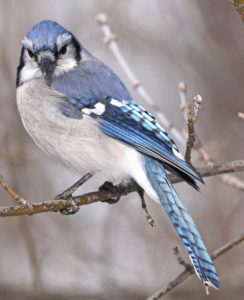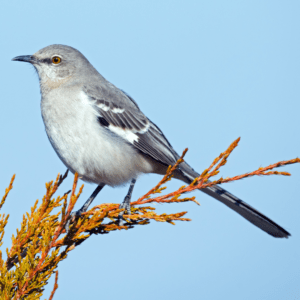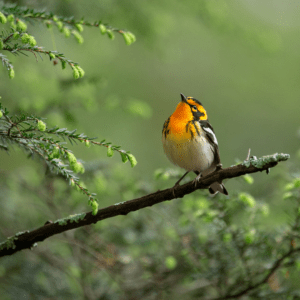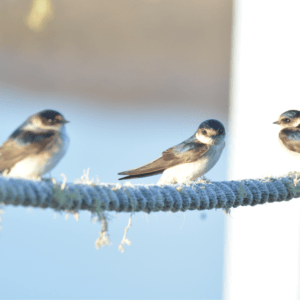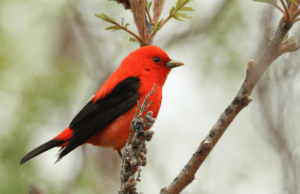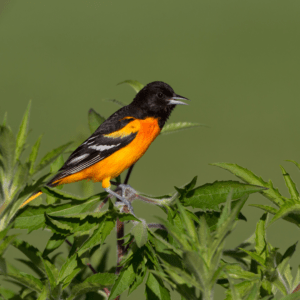Yes, birds do eat butterflies, and they also eat caterpillars, larvae, and eggs.
However, this begs the question, does every species of bird eat butterflies, or do some avoid them?
Further, do birds choose to eat butterflies? Or do they only eat them if they can’t find anything else?
Today, we’ll fully answer these questions and explore: do birds eat butterflies?
We’ll also answer the following:
- Do birds eat moths?
- How do butterflies avoid birds?
- What types of butterflies do birds avoid?
What Birds Eat Butterflies?
In the below table, we look at which birds most commonly eat butterflies.
But before we do that, we’ll quickly answer one of the earlier questions: do birds eat moths?
Birds do eat moths. This includes moth caterpillars and eggs, too.
In addition to the species of birds that eat butterflies, we’ll highlight which birds also eat moths in the below table.

Species of Birds that Eat Butterflies
Species | Defining Feature | Other Prey | Similar Species |
Grosbeak
| Depending on the gender and species of the grosbeak, they have different defining features. For example, adult male rose-breasted grosbeaks can be recognized by the red on their breast, and females will have brown streaks. | Grosbeaks also eat:
|
|
Blue Jay
| Bluejays can be recognized by their bright blue colors and black necklace. | Blue Jays also eat:
|
|
Northern Mockingbird
| To recognize a Northern Mockingbird, look for its brown body contrasting with its much lighter chest. | Northern Mockingbirds also eat:
|
|
| Sparrows are very common and can be identified by their small size, triangular bill, and brown back wings. Related: How Long Do Sparrows Live? | Sparrows also eat:
|
|
Warblers
| Warblers can be challenging to recognize, as they come in many different colors and are constantly in motion. They also look like wrens (who also eat butterflies). In short, look for the markings around the warbler’s eyes, bright colors, and short bills. Be careful of warbler neck when on the lookout! | Warblers also eat:
|
|
Martins
| The easiest way to identify a male martin is its dark blue colors and black wings. A female martin is grey with white on its belly. | Martins also eat:
|
|
Tanagers
| Male summer tanagers are easily identifiable through their bright red features. Female tanagers are yellow with a pale bill | Tanagers also eat:
|
|
Orioles
| The best way to recognize orioles is to look for a black head and wings with an orange-yellow body. | Orioles also eat:
|
|
Note that the above isn’t a definitive list. The majority of backyard birds eat butterflies, and seagulls eat just about anything! However, those listed above particularly enjoy butterflies, and won’t hesitate to eat one, even when other food is abundant.
That said, some birds avoid butterflies. For example, maritime birds, like pelicans, penguins, and terns mostly eat fish, shrimp, and crustaceans. American Goldfinches don’t eat butterflies, either, and prefer to diet on seeds. They might have the occasional butterfly — but only by accident.
How do Butterflies Avoid Birds
Butterflies have various defense mechanisms to help them avoid birds. For example, butterflies fly erratically to make themselves more difficult to catch. You’ll notice it next time you see a butterfly — note how they never fly in a straight line!
Not only that but the wings on both butterflies and moths are made up of hundreds of tiny scales. These scales are detachable (which is a great help if a butterfly or moth gets caught in a spider’s web), making them quite slippery. In other words, even if a bird manages to catch a butterfly or moth, it’ll often escape anyway.
Can birds eat Monarch Butterflies?
One interesting butterfly species with an extra defense mechanism is the monarch butterfly — which you can recognize by its brightly colored orange wings. monarch butterflies are toxic and are a species of butterfly that most birds avoid.
What’s interesting about the monarch butterfly is that their toxicity isn’t something they’re born with.
When monarch butterflies are caterpillars, they eat milkweed leaves. Milkweed leaves contain glycosides, a naturally occurring toxic chemical. monarch caterpillars can store and retain this chemical.
Later, when monarch caterpillars reach their metamorphosis stage, they develop into monarch butterflies. When they do, they still retain the glycosides from the milkweed leaves, making the fully-grown monarch butterfly toxic.
That said, a young bird won’t necessarily know it shouldn’t eat monarch butterflies. When it first sees one in the wild, it will try to eat it, but after doing so, it will become sick. Luckily for the bird, the sickness isn’t fatal. However, it’s enough for the bird to learn that it needs to avoid eating monarch butterflies in the future.
What Else Can Birds Eat?
Most backyard birds can also eat insects, berries, and the occasional fruit. If you want to learn more about what a bird can or can’t eat, you can start by checking out can birds eat flax seeds?

Sam is a nature enthusiast who’s been birdwatching in both the old and new world. He even enjoys an annual tradition of watching kittiwakes nesting on the cliffs of Southern England

